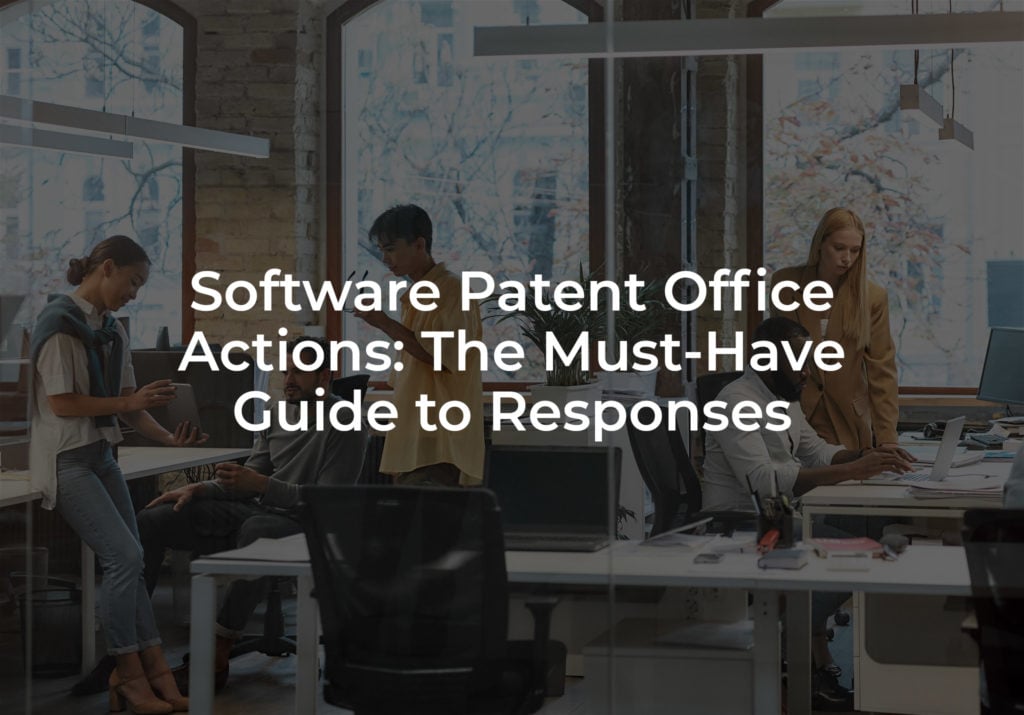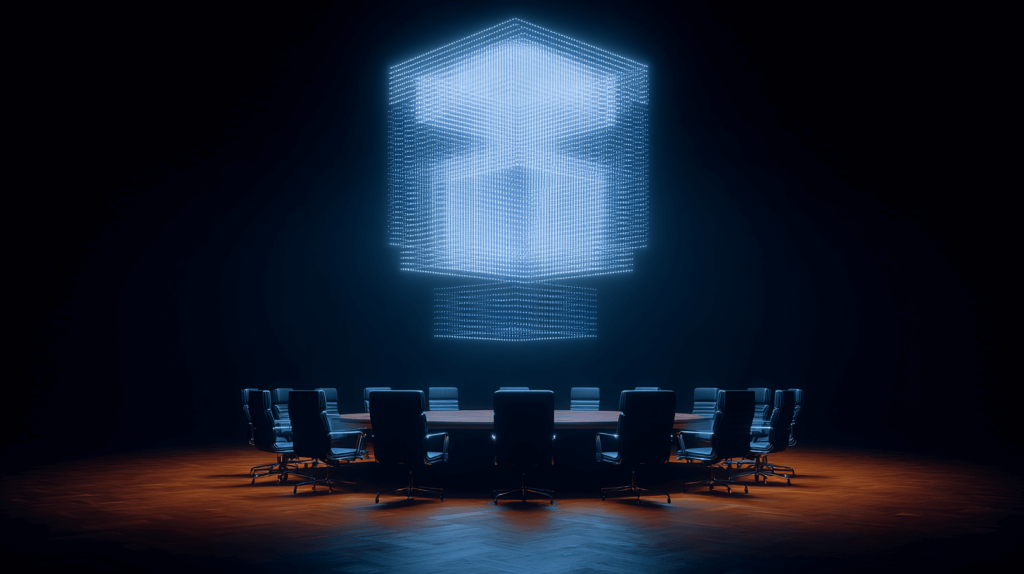Filing a patent application is only the first step toward receiving a registered patent. Next, the USPTO assigns a Patent Examiner (Examiner) to review and analyze the patent application for patentability and compliance with legal formalities. The Examiner will issue a report on the patentability of the patent application, including one or more rejections and/or legal objections in a document called an “Office Action.” As such, a Software Patent Office Action advises you about any modifications required for your patent application.
To prosecute your application forward to allowance and issuance of a registered patent, you need to respond to each of the issues raised in any Office Action you may receive. Failure to adequately respond to an Office Action will result in the abandonment of your patent application.
The USPTO provides information online for responding to Office actions. But why does the USPTO issue Office Actions? In a nutshell, inventors (and their patent attorneys) usually try to claim the broadest scope of protection possible for their invention, which will grant them a limited monopoly over the claimed invention. The USPTO, as a government entity with the interests of the public in mind, pushes back by stating the reasons why it believes that the claims are too broad and by outlining any informalities or legal issues present in the patent application.
In this guide, we break down Office Actions into pieces of information that will help you:
- Understand the different rejections, objections, and comments in an Office Action and what is required in a response;
- Understand what is happening to your patent application as it is being examined; and
- Make business decisions based on modifications to the scope of your claims in your patent application
To begin, we will describe what is a Software Patent Office Action. Then we will examine the different types of Office Actions. We will follow this up with a discussion about how to prepare responses to Office Actions and conclude with a few comments and helpful guidance.
What is a Software Patent Office Action?
When the USPTO receives a patent application, it is placed in a queue for examination. The average time it takes before an application is examined has varied throughout the years and by different technologies contained in the application, but generally, you can expect to wait around eighteen months before an Examiner will review your application for the first time.
After the Examiner has completed their examination of your patent application, the Examiner details any grounds for rejection or objection in a Software Patent Office Action. An Office Action can raise one or more issues regarding any part of the patent application. However, the primary focus of the examination is on the claims. The claims are examined for both formalities and patentability. The other parts of the patent application are examined for formalities and to determine whether they provide adequate support for each of the claims. An Office action can raise any of the following issues:
- Rejection of claims based on prior art
Only claims can be “rejected.” Rejections can be made based on prior art. Prior art can be one or more publicly available documents that the Examiner cites as disclosing the features claimed in your patent application that existed before your patent application’s filing date (or priority date, when your application claims benefit to a previously filed application). If multiple claims are pending, some of the claims might be rejected while others could be allowed and/or objected to.
- Other claim rejections
Claims can also be rejected for reasons other than prior art disclosures. These rejections can be issued by the Examiner due to the form of the claims and/or compliance with applicable patent laws. For example, if a claim recites an invention that the patent application does not describe, or if a claim is directed to any non-patentable subject matter (such as an abstract idea), the Examiner will reject the claim on that basis.
- Objection to claims
Generally, a patent application will include one or more independent claims and a series of dependent claims. Independent claims stand on their own and do not refer to (or “depend” on) any other claims. Dependent claims refer to (or “depend” on) an independent claim or another dependent claim, and thereby include or inherit all the limitations and elements of the claim, or chain of claims, to which the dependent claim refers. If the dependent claim in question is allowable but for the rejection of the independent claim that it depends on (and the dependent claims in the chain, if any are present and also rejected), then the dependent claim in question will be objected to based on the rejection of claim(s) on which it depends.
Examiners are required to provide a comprehensive explanation to support each rejection/objection raised in an Office Action. One or more claims may be rejected based on one or more issues the Examiner cites, such as existing prior art references and/or failure to comply with legal requirements. However, we have included below some of the most common grounds why SaaS patent applications receive an Office Action.
- Obviousness
According to 35 U.S.C. § 103, a claim may be rejected if “the claimed invention as a whole would have been obvious before the effective filing date of the claimed invention to a person having ordinary skill in the art to which the claimed invention pertains.” Most obviousness-type rejections are based on the combination of two or more references (for example, patents and published patent applications) including the reasoning for the combination of the cited references. However, in some instances a single reference obviousness rejection may be issued.
- Anticipation
Rejections based on anticipation are rejections based on a single reference disclosure or publication that occurred more than one year before the filing date (or priority date) of the patent application. These rejections find statutory support in 35 U.S.C. § 102, which also indicates that if a claimed invention is described in a printed publication, in public use, on sale, or otherwise available to the public before the effective filing date of the claimed invention, it is not patentable. This follows under the principle that if something existed anywhere in the public domain (i.e., worldwide) not a new or novel invention if someone later claims it.
Often found in rejections of claims directed to software inventions, business methods, and computer-implemented processes, subject matter rejections usually occur when the Examiner argues that the subject matter of the claimed invention is not eligible for patent protection because it is directed to an abstract idea or other non-patentable subject matter under 35 U.S.C. § 101.
Non‑Patentable Subject Matter rejections in software and SaaS patent applications require special attention. The issue is best understood by discussing the general patent eligibility requirements, the judicial exceptions to patent eligibility, how US Supreme Court decisions have shrouded the matter in mystery, and how the USPTO guidance relates to these matters.
Under 35 U.S.C. § 101, there are four categories or types of inventions that are eligible for patent protection: process, machine, manufacture, or composition of matter (or any new and useful improvement thereof). Software and SaaS inventions arguably fall under the “process” category of inventions. And if the invention is claimed as a machine (i.e., computer) that implements the process, an aspect of the invention would fall under the “machine” category.
Courts have interpreted the four statutory categories of inventions to exclude “laws of nature, natural phenomena, and abstract ideas.” These terms commonly referred to as “judicial exceptions” to patent eligibility, generally refer to basic knowledge that is not eligible for patent protection, such as scientific principles (e.g., that force equals mass times acceleration, or F = mA), naturally occurring phenomena (e.g., lightning, gravity, sunlight), mental processes, and mathematical algorithms. As you probably guessed, the last two exceptions (mental processes, and mathematical algorithms) are the foundation for the majority of SaaS patent application Office Actions.
To help applicants navigate the fast-paced changes to claim interpretations in the computer, software, and SaaS technology areas, the USPTO has issued an updated guidance on subject matter eligibility. This guidance has also been incorporated into various sections of the USPTO’s Manual of Patent Examining Procedure (MPEP). MPEP § 2106 currently states the test for subject matter eligibility involves the following steps:
- Step 1: Check whether the claim is directed to a statutory category (process, machine, manufacture, composition of matter, or improvement thereof). If “no,” then the claim is directed to subject matter ineligible for patent protection. If “yes,” go to Step 2A.
- Step 2A: Check whether the claim is directed to a statutory exception (laws of nature, natural phenomena (product of nature), or abstract idea). If “no,” then the claim is directed to subject matter eligible for patent protection. If “yes,” go to Step 2B.
- Step 2B: Check whether the claim recites additional elements that amount to significantly more than the judicial exception. If “no,” then the claim is directed to subject matter ineligible for patent protection. If “yes,” then the claim is directed to subject matter eligible for patent protection.
An Office Action Amendment to a computer-implemented technology, software, or SaaS patent application requires:
- Analyzing the Examiner’s reasoning for each step of the subject matter eligibility test.
- Finding any weaknesses in the reasoning of each step.
- Did the Examiner fail to properly apply any of the steps?
- Find analogies in example cases provided in the USPTO guidance.
- Is it possible to explain how the claim falls into any statutory category?
- Respond and argue, if possible, the analysis of the Examiner in each step.
These issues are more complicated than what can be summarized here. We have found that the best strategy is to succinctly articulate the points of distinction in your inventive concept, novelty, and improvements within your application against the Examiner’s cited references. If you are addressing the response yourself, we highly recommend reviewing the USPTO guidance and the MPEP.
However, in view of the complexities surrounding subject matter eligibility in computer, software, or SaaS patent applications, we highly recommend that you hire a patent professional experienced in software to assist.
With a patent attorney, you can focus on identifying and providing the technical information that can be used to argue subject matter eligibility. For your current claims and/or for new amendments, you can:
- Clarify the inventive concept behind your technology and articulate the novelty.
- Explain how you are making a technological advancement and/or improvement and not using a generic computer functionality.
- Explain how your invention embodies a practical solution and not an outcome.
- Explain which elements in your claims incorporate the inventive concept.
- Explain how the claim elements are directed to improvements to computers or technology.
This type of information is essential when drafting proper amendments and/or find the best arguments to traverse the rejections and move your patent applications towards allowance.
Types of Patent Office Actions
There are two types of Office Actions: Non-Final Office Actions and Final Office Actions. Both Non-Final and Final Office Actions will have one or more of the rejections and/or objections discussed above.
When you receive a Non-Final Office Action, you have an opportunity to amend the claims and make any other revisions within the application (without introducing new matter) in an attempt to place the claims and the whole patent application in condition for allowance. However, if the amendments and arguments in the response to the Non-Final Office Action fail to be persuasive, the Examiner will likely prepare and issue a Final Office Action.
A Final Office Action is issued when the response to the Non-Final Office Action fails to remedy or adequately address all of the issues raised in the Non-Final Office Action, or when the response raises new issues that impede the allowance of the claims.
From a practical point of view, Examiners are required to review the amendments to the claims in a response to a Non-Final Office Action, but Examiners may not be required to examine amendments or new arguments in a response to a Final Office Action, except in limited circumstances.
37 C.F.R. 1.116(b) states that amendments after a Final Office Action are allowed for (1) canceling claims or complying with any requirement of form expressly outlined in a previous Office Action, (2) presenting rejected claims in better form for consideration on appeal, or (3) touching the merits of the application upon a showing of good and sufficient reasons why the amendment is necessary and was not earlier presented.
If you receive a Non-Final Office Action, and you reply with amendments to the claims, if the Examiner needs to find a new prior art or present new reasoning for the rejection, the Examiner may still issue a Final Office Action, except in a limited number of circumstances. The most common of these exceptions occur when the Examiner introduces new ground for rejection that is not necessitated by an Applicant’s amendment of the claims.
How to Respond to an Office Action
There are various strategies that an Applicant can use when responding to an Office Action. The most common strategies and responses are explained below.
- Interview the Examiner
An Examiner Interview is a pre-scheduled discussion with the Examiner, generally conducted over the telephone, regarding the claim rejections and/or objections outlined in the Office Action and potential amendments addressing these concerns. Applicants represented by a Patent Attorney can but generally do not actively participate in the interview. In some instances, the Inventor and/or Applicant may be interested in attending the Examiner Interview.
However, please keep in mind that saying the wrong thing or making an improper admission during an Examiner Interview can affect the chances of obtaining a patent registration. In some situations, the Interview leads to an Examiner’s Amendment, placing the claims in the application in condition for an allowance without the Applicant having to file a formal response to an outstanding Office Action. Interviews can be Examiner initiated or requested by the Applicant.
One of the best ways to prepare for an Examiner Interview is to fully consider the issues raised in the Software Patent Office Action and how best to frame your response to the Office Action. Then you may prepare an agenda of items to discuss. Next, you may contact the Examiner and schedule a convenient time to discuss the Office Action and proposed response and to email the agenda with any proposed amendments to the Examiner.
Then, you can discuss with the Examiner to better understand the reasoning behind their rejections and their interpretation of terms and phrases and take the opportunity to highlight and clarify any misunderstandings or differences of interpretation.
- Reply / Response to the Software Patent Office Action
A response to an Office Action requires detailed attention to each rejection, objection, and any other issue raised by the Examiner in the Office Action. Failure to address every issue in the Office Action may result in further rejection of the patent application, additional fees, and even abandonment
Generally, claim rejections that cite prior art will provide detailed reasoning for the rejection. You have two options in response:
- Argue that the rejection is improper (e.g., that the Examiner failed to consider all of the elements of the rejected claim, that the Examiner misconstrued the claim and/or the cited prior art, that the multiple prior art disclosures cannot be properly combined, that prior art that was published after and not before the effective filing date, that the Examiner’s reasoning was flawed or faulty, or other arguments); and/or
- Amend one or more of the rejected claims and argue that the amended claims overcome the rejections
The same strategy may be used when addressing an objection: argue that the objection is improper and/or amended to overcome the objection. Objections can also be placed in abeyance during the prosecution of the patent application, which is often done when a dependent claim is allowable but for the rejection of an independent claim to which the dependent claim refers.
This type of response is only available after a Non-Final Office Action or after a Final Office Action in the situations described above (canceling claims or complying with form requirements, presenting rejected claims in better form for consideration on appeal, or touching the merits of the application upon a showing of good and sufficient reasons may also be proper). Outside of these instances, for the Examiner to consider a response after a final Office action, you can file an RCE (Request for Continued Examination).
- RCE – Request for Continued Examination
Simply put, an RCE is another opportunity to continue to prosecute your application. Generally, an RCE is filed with a response to a pending Office Action, similar to a response to a Non-Final Office Action. If the amendments filed in the response with the RCE require new grounds of rejection, the Examiner will issue a new Non‑Final Office Action. In some cases, the Office Action may be Final, if the claims are identical or patentably indistinct from the previously examined set of claims and if it would have been proper to issue a Final Office Action if such claims had been entered as a response to the prior Office Action.
RCEs are only available after a Final Office Action is issued.
- Continuation Application
A continuation application is a new application that claims the benefit of the effective filing date of its parent patent application. A continuation application cannot introduce new matter but can and often does contain claims that are different and distinct from the claims in the parent application. A continuation application must be filed while the parent application is still pending (i.e. the parent application has not been abandoned).
Once the continuation application is filed, the parent application may be abandoned or both applications may be prosecuted. However, an application and its continuation application cannot have the same claims under examination while both are pending.
- Continuation-In-Part Application
A Continuation-In-Part application, or CIP, is an application that claims the benefit of the effective filing date of its parent patent application and adds new matter not disclosed in the parent application. Note that claims that depend on the new matter for support do not receive the benefit of the effective filing date of the parent application if they are directed to the newly presented matter. Like continuation applications, CIPs must be filed while the parent application is still pending.
- Divisional Application
A divisional application may be required or occur in response to a restriction requirement. A restriction may be issued when the Examiner finds that an application contains claims directed to patentably distinct inventions (in other words, claims directed to multiple different inventions). Generally, the Examiner will identify two or more subsets of claims within the pending set of claims and each subset will correspond to a distinct invention. The applicant can argue against the restriction, or select one set of claims for Examination, withdrawing all of the other claims from the application. If the applicant then chooses to prosecute another claim set, the applicant may file a divisional application with the chosen claim set.
Divisional applications can also claim the benefit of the effective filing date of their parent patent applications.
- Appeal
Once any claim is twice rejected, the Applicant may file an appeal. An appeal is a procedure to take an issue raised by the Examiner for secondary review before Patent Judges of the USPTO Patent Trial and Appeal Board. This procedure is often used for high-value patents, particularly when the Applicant and the Examiner cannot reach an agreement regarding a particular issue.
The Applicant presents this issue in an Applicant’s brief as an error by the Examiner and respectfully discusses the Applicant’s reasoning. The Examiner prepares an Examiner’s Brief in response. This procedure can be significantly more expensive than filing an RCE or a continuation application.
Periodically the USPTO will introduce pilot programs to aid in the prosecution of Software Patent Office Action and reduce the pendency time for applicants. For example, the USPTO is currently implementing the After Final Consideration Pilot 2.0 (AFCP 2.0). The A.F.C.P. 2.0 provides applicants an opportunity to present an amendment to at least one independent claim that does not broaden the scope of the independent claim in any aspect. If the Examiner believes that the response can be fully considered and that claims can be reexamined without additional or with minimal prior art searching then the Amendment may be considered.
How Much Does It Cost to Respond to A Patent Software Patent Office Action? And How Do I Get a Started?
At the Rapacke Law Group, we offer a Free Office Action analysis and provide one transparent for the preparation and filing of your Office Action based on the technology, and complexity of issues presented.
Our all-inclusive flat-fee covers one revision and an examiner interview if your non-provisional patent application receives an office action.
Consult an Experienced Patent Attorney. The Rapacke Law Group is an intellectual property law firm built for the speed of business innovation, with patent attorneys experienced in a myriad of technologies, including software, SaaS, FinTech, and business methods. At the Rapacke Law Group you will receive a fixed fee quote for the entirety of your project without the hassle of hourly billing or surprise invoices. Call to speak with one of our attorneys today or take our online IP Quiz here.
Related Article: Debunking the Biggest Software Patent Myths




